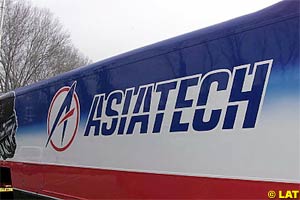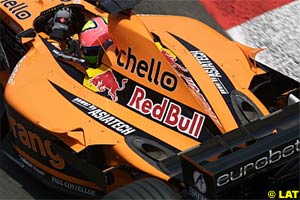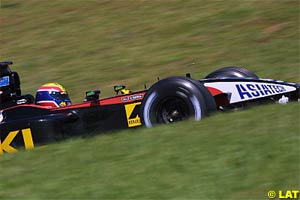
Interview with Scalabroni and Gano
Atlas F1 Technical Writer
Asiatech may have entered Formula One through the back door, and their quiet and silent approach has not helped them make the headlines in two seasons in Grand Prix racing. But behind their almost mysterious image there's a lot more. Atlas F1's Will Gray talked exclusively to Enrique Scalabroni and John Gano, the men in charge of carrying out Asiatech's masterplan
But the plans are certainly not a new idea. They have been the ultimate goal all along, and the route they have taken to get into the position where they are ready to offer their services as a chassis manufacturer has been steered by none other than Formula One ringleader Bernie Ecclestone.
"The real story is this," began Scalabroni. "We came here to set up a team, but we decided to go for the engine." Gano added: "We talked to Bernie Ecclestone (before entering Formula One) and he said 'Where's your engine?', they were his first words to me. He said: 'This is something we must reflect on'. Smart man! We had to sort out the problem of the engine before we sorted out the problem of the car."
Former Ferrari designer Scalabroni and Gano, Asiatech's financial director, developed a mysterious consortium, the parties of which neither would disclose, to develop their business plan and the strategy with which they would create their Formula One team.
They purchased the Peugeot factory, in Velizy, near Paris in France, along with its engines and assets, snapped up the old Williams factory in Didcot, England, and added a Swiss finance house to their numerous bases to create a network which combined together to create Asiatech.
What they have been building up to, and what they are now trying to sell to one of three different manufacturers or one of four existing teams with whom they have already had discussions, is, as Gano described in true American tele-commercial style "one-stop shopping".
He explained: "We have the engine, we have the chassis design, we have the ability to manage - at a controlled cost of less than half of the big team budgets - a podium class team."
It is, in effect, the same type of business philosophy under which race car manufacturers Lola, Dallara and the now bankrupt Reynard, operate, only in their cases they make numerous cars for different series' around the globe, not just the machines for a two-car Grand Prix team.
Lola, for instance, design and manufacture the entire grid of Formula 3000 cars and also provide, among other categories, chassis for the American Champ Car series. But their financial structure comes from the sale of mini-mass produced machines, so what is Asiatech's philosophy?
"The way we can do this," Gano began to explain. "We have already demonstrated that with the engine. We have taken an engine that had problems when we acquired the programme (from Peugeot) and re-organised the factory.
"Now, even compared to last year's budget, for 30 percent less cost we are making an engine that is more reliable and with ten horsepower above what we had last year, which was higher than that of the year before.
"So we are making serious gains in cost cutting and improving quality and performance, and with the concept that we have for the engine and chassis team, which is more of a modularised structure, we can deliver quality at a lower cost. It is as simple as that. That is the business model."
How it works, then, still remains a mystery and although they claim to have spoken to four teams currently in Grand Prix racing, it seems unlikely that any would be interested in ditching their design and manufacturing staff or even combining with an additional design team.
"There are two different options," said Scalabroni. "One option is to produce a prototype for testing, something like Toyota, the other is if we join a team that joins with us in the philosophy of the development of the car, then they will build the car.
"You see some teams that are leaving so many people in the street because maybe they have some financial problems but what we want to do is to run an advanced conceptual engineering group that can help any team that is associated with us.
"In that case we can be designing the car or developing the car or the aerodynamics, or designing a new transmission or anything, but costing less on the research for the team and it will help us to have something that is more integrated. At the moment we need to decide what we will do next year to take that decision."
That decision, if they want to combine with a current team, will have to come by July, but ideally earlier, because many teams will have already begun discussions and initial design work on their 2003 machines.
It remains to be seen whether the Audi brand was bracketed into the quote from Frans-Josef Paefgen, the chairman and chief executive of Bentley Motors, who direct the VW group's motorsport activities, that "for VW there will definitely be no Formula One programme".
And there are still a number of manufacturers out there, most notably, perhaps, General Motors, that have yet to commit to Formula One. Asiatech's 'branded team' philosophy could just be the thing to tempt them in. Gano agreed, returning back to his original discussion with Ecclestone: "The second thing that we were told is that in the future of Formula One the best thing is to be linked with a road car company.
"What we can say about the future of our funding is that we have come to realise the wisdom of that instruction, especially with the changes in the world economy of the last two years, and we clearly want to be linked with a major road car manufacturer.
"We want to make a team that takes advantage of the co-design principle at less than half the cost of the current big team budgets. Our goal all along has been to make an integrated team, co-designing the engine and the chassis, and this is the world that Enrique Scalabroni has lived and worked with in his period at Ferrari."
It is certainly not uncommon for a team to be run by a professional motorsport company and branded as a 'works' car. It happens a lot in touring car racing, where, in Britain, a company called Triple Eight runs the Vauxhall team while the MG team is run by West Surrey Racing.
Asiatech's idea, then, may be just what Formula One needs. A professional outfit in the background, with the name providing the funding, and it could point the finger to a possible direction for some of the other teams that are struggling to survive.
It all depends, of course, on whether any manufacturer is really interested in coming into Formula One, and Ferrari's domination and controversial moves at the head of the sport will not do any favours to Asiatech or any of the smaller teams who could contemplate a similar move.
One crucial thing for Asiatech's plan to work, however, is their ability to prove how competitive their design could be. They remain, as yet, a relatively unproven company. But behind the scenes they have been working away to set up a technical operation which is a viable proposition for any interested parties.
They claim to be in the advanced stages of development, having created a design which includes a gearbox that, according to Gano, is smaller, lighter and stronger than anything currently used in Formula One. Scalabroni says his team have already performed significant testing. They have now completed three months of wind-tunnel work and are starting to create the definitive design.
In one month, Scalabroni says, they will have completed the final shape of the car, and will be ready to build it. From then, the only thing that remains is to sell it. But there seems to be no rush.
"Technically we would be ready, with a link-up with an existing team to co-design and work with them by the 2003 season," said Scalabroni. "If it's starting a new team then it is 2004 at the earliest.
"We are under no pressure to do in two years what people like Frank Williams still haven't done in twenty years, which is to acquire his engine factory as well as a chassis. This is our programme, we are moving step by step, faster than we thought we would move, because we kept our heads down. In 15 months we have come a long way."
It was little more than a year ago that the name Asiatech arrived in Formula One but since the France-based company joined the sport as engine suppliers to Arrows at the start of 2001 they have remained relatively anonymous, faceless, and undiscussed.
 Now engine suppliers to Minardi, Asiatech have a motorhome presence alongside the back-of-the-grid outfit, but their top bosses are rarely seen at the racetracks. Mystery continued to surround them until reports suggesting they had plans to create a new team surfaced and, at last weekend's Austrian Grand Prix, were confirmed, by project leaders Enrique Scalabroni and John Gano.
Now engine suppliers to Minardi, Asiatech have a motorhome presence alongside the back-of-the-grid outfit, but their top bosses are rarely seen at the racetracks. Mystery continued to surround them until reports suggesting they had plans to create a new team surfaced and, at last weekend's Austrian Grand Prix, were confirmed, by project leaders Enrique Scalabroni and John Gano.
 Asiatech believe they have created an efficient technical plan that enables them to create a car and engine package at a much-reduced cost, one that they could offer as a ready to race machine. Their philosophy, basically, is if you want to race then just get your team together and we will design the car.
Asiatech believe they have created an efficient technical plan that enables them to create a car and engine package at a much-reduced cost, one that they could offer as a ready to race machine. Their philosophy, basically, is if you want to race then just get your team together and we will design the car.
 Realistically, the only way their plan could sensibly work is as a made-to-order car for one of the major manufacturers still considering entry into the sport. But as recently as last weekend, Peugeot and VW denied plans to join Formula One.
Realistically, the only way their plan could sensibly work is as a made-to-order car for one of the major manufacturers still considering entry into the sport. But as recently as last weekend, Peugeot and VW denied plans to join Formula One.
 "We have been working to create enough information for the engine as well as the aerodynamic point of view and the tyres and things," said Scalabroni. "We decided to create, in England, a technical research centre, a conceptual design centre, to have people from Formula One working under us and putting together to design the car from an aerodynamic point of view."
"We have been working to create enough information for the engine as well as the aerodynamic point of view and the tyres and things," said Scalabroni. "We decided to create, in England, a technical research centre, a conceptual design centre, to have people from Formula One working under us and putting together to design the car from an aerodynamic point of view."
Please Contact Us for permission to republish this or any other material from Atlas F1.